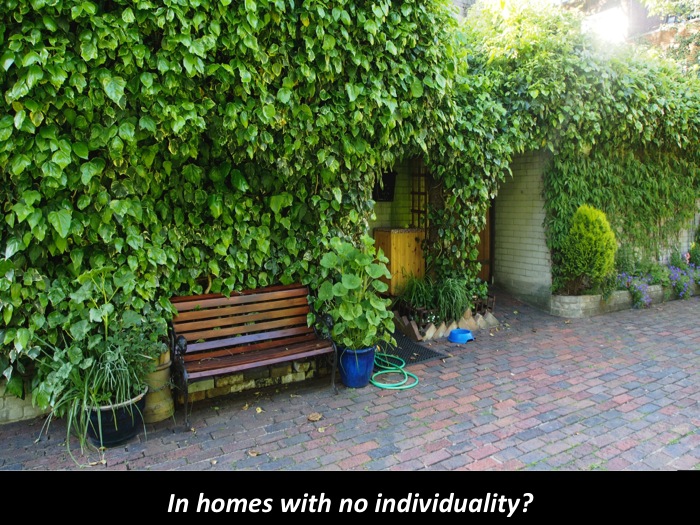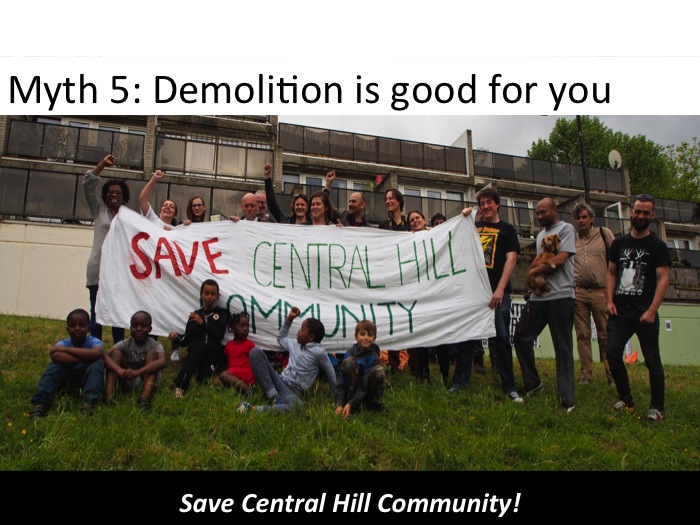
We are repeatedly told that London is facing an unprecedented housing crisis, and it is generally agreed that we must build 50,000 new homes a year to address this. We are told that the newly categorised brownfield land available to local authorities is mainly on council estates – and that these estates, as a direct result of their architecture, are havens for crime, drug-taking and anti-social behavior, and in states of decay beyond repair. We are told, in addition, that due to Central Government cuts, local authorities can no longer afford to subsidise council housing, so the only option they have is to demolish existing estates and rebuild them at higher densities, providing the additional market and affordable housing needed to fill the gap. At the same time, we are told that estate regeneration improves the economic and social well-being of the existing residents, housing them in homes that will be built to much higher environmental and other standards.
 As anyone who is involved with the reality of estate regeneration will know, this is all a load of Owellian Newspeak, designed and propagated by those who stand to benefit from this so-called housing crisis, and that includes property developers, housing associations, politicians and architects. At ASH, we believe that in order to begin to address this so-called crisis we must challenge the propaganda we are being fed, to question its role, and who stands to benefit from what is being proposed. Architects are very good at solving problems – but first we need to identify the right problems by asking the right questions.
As anyone who is involved with the reality of estate regeneration will know, this is all a load of Owellian Newspeak, designed and propagated by those who stand to benefit from this so-called housing crisis, and that includes property developers, housing associations, politicians and architects. At ASH, we believe that in order to begin to address this so-called crisis we must challenge the propaganda we are being fed, to question its role, and who stands to benefit from what is being proposed. Architects are very good at solving problems – but first we need to identify the right problems by asking the right questions.

This is is not a housing crisis. This is a housing boom. Current local and central government housing policies – both Tory and Labour alike – are exacerbating, not addressing, what is a crisis of affordability, not a crisis of supply. The demolition of our council estates – which are home to pretty much the only low cost housing left in London – is causing more problems than it is solving.

Simply building more unaffordable housing will not solve the problem of affordability. As Danny Dorling pointed out, according to the 2011 census we are living in a time where there are more rooms per person than ever before. Architects should be focusing their efforts on the affordabilty aspect of this housing crisis and be exploring ways to build more cheaply, not contributing to the glut of luxury housing which is only making things worse.

Again, This is simply not true. The top 9 building companies are currently sitting on land on which you could build 600,000 homes in England. This is a deliberate attempt to drive up the price of land. In Inside Housing magazine in 2013, Colin Wiles showed that there is twice as much land in UK given over to golf courses than to there is to housing.

Estates like the Barbican and Central Hill, depicted here, clearly demonstrate that there is no relationship between architecture and crime or anti-social behavior.

On the contrary, on all the estates we have worked with, including the Aylesbury and Heygate, crime is in fact lower on the estates than in the surrounding areas.

It is the managed decline of estates by the local authority or housing association, and the subsequent denigration of estates by the media, that facilitates their demolition.

These images show some of the residents of Central Hill Estate at an event, organised by ASH, that took place on estates across London over the last two years . Called Open Garden Estates, it was designed to challenge the myths about council estates.

In terms of improving the lives of residents on council estates, Joseph Rowntree’s report in May of this year showed that regeneration projects have a negative impact on existing residents. Increased rents make their economic position worse, pushing people into private rental accomodation and homelessness, and uprooting the community from the support networks that are the bedrock of our social infrastructures.

In terms of financial ‘viability’, refurbishment, rather than being the more expensive option, has consistently been shown to be significantly more cost effective than full demolition and redevelopment. The environmental benefits of demolition of estates and their replacement with energy efficient new homes will only be reaped in around 60 years’ time, and I doubt whether much of what is being built now will last even half of that. A Wandle housing association estate in Peckham has been condenmed after only 6 years, which seriously challenges the widely-accepted belief that what we are building now is of a higher quality than what is being torn down.

Now that this insidious term ‘affordable’ has been accepted in the policy lexicon, there is no longer any requirement to provide any homes for social rent; and in planning documents, local authorities and housing associations – including Notting Hill Housing at the Aylesbury Estate, the Guinness Partnership at Northwold Estate, and Peabody at Thamesmead Estate – are consistently replacing social rent with affordable. As you can see, a 4-bedroom ‘affordable’ flat on Central Hill Estate would be nearly four times the rental cost of an equivalent sized flat for social rent. ‘Affordable’ housing is not affordable to the people whose homes are demolished to make way for it.

In fact, through their rent, tenants on council estates pay off the full cost of the housing they use, plus their share of the construction debt. Far from being subsidised, most post-war estates have more than paid off their construction costs years ago, are in fact now making considerable profits for the local authority. On the contrary, it is legislation like Right to Buy, Help to Buy, and the sale of ‘affordable’ and ‘Starter Homes’, that puts public subsidies into private hands. Southwark Labour Council sold the Heygate Estate to property developers Lendlease for £50 million, around one-tenth of its land value, and its redevelopment cost Southwark Council £80.5 million in evictions, demolitions and redevelopment, with only 82 of the 2,535 homes promised for social rent.

We have a duty as architects to the wider environment, and that doesn’t just mean some abstract notion of environmental sustainablity, but refers to all communities affected by our work. We have a professional responsibilty to question the brief, and an obligation to demand that the client properly explore alternatives to demolition when we know that almost every estate regeneration scheme to date has resulted in the net loss of social or council housing.

Residents of West Kensington and Gibbs Green estates have been fighting for their homes for the last seven years against the developer Capco, which intends to demolish their estates as part of their £2 billion Earls Court redevelopment plan in which, the last time we heard, they were proposing a mere 11 per cent affordable housing. Over nearly a year ASH worked closely with around 200 residents of over 750 homes to come up with an alternative to demolition. This is now part of their business plan for their application for a Right to Transfer the estate into their ownership.

As a result of our consultation with residents, and through a combination of infill and roof extensions, we identified the opportunity for between 250-350 new homes on the two estates, an increase of around 35-40 per cent, without the demolition of a single home or eviction of a single tenant.

Privately renting or selling a proportion of the new homes would generate the funds to refurbish and improve the existing council homes, landscape and communal facilities, while leaving the communities they currently house intact.

Similarly, on Central Hill in Crystal Palace, an estate that is threatened with demolition by Lambeth Labour Council, we have worked with residents over the past 18 months to come up with an alternative to demolition that includes infill, roof extensions and new communal facilities – which, incidentally, residents are currently prohibited from using as part of the Labour Council’s efforts to extinguish the community’s resistance to their plans.
ASH has identified the opportunity for new community facilities and over 200 new homes, the rent or sale of a portion of which could easily pay for the refurbishment of the 456 existing homes as well as improvements to the landscape.

Far from solving the housing crisis, the current programme of estate regeneration is actually driving it. Both Tory government and Labour councils are united in pursuing this policy of social cleansing, and it’s time that architects decided whose side they are on: the estate communities fighting for their homes and lives, or the property developers, housing associations and councils getting rich on their demolition.
Geraldine Dening
Architects for Social Housing
Reblogged this on Wessex Solidarity.
LikeLike